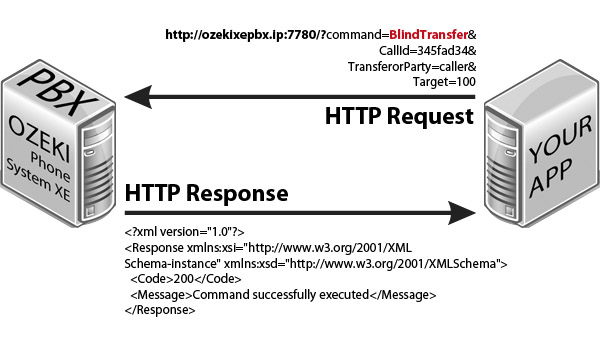BlindTransfer
The BlindTransfer command is used to connect two phones together. If the connection is established, the phone which connected the phones together will leave the conversation. You can see how to use this command in a HTTP request and what HTTP response you will get from the phone system (Figure 1).

Request parameters
| Parameter name | Value | Description | Mandatory |
| command | string value, BlindTransfer | Specifies the type of the HTTP API command. | Yes |
| CallId | string value, e.g. H2Wwb |
The call ID of the call you want to run the BlindTransfer command on. | Yes |
| TransferorParty | string value (caller or callee) |
The party member who will make the transfer. | Yes |
| Target | int value, e.g. 1001 |
The phone number you want to transfer the party member to. | Yes |
| These parameters are only required if office user authentication is set in the HTTP API: | |||
| Parameter name | Value | Description | |
| Username | string value, e.g. user1000 |
This is the username of an Ozeki Phone System office user. | |
| Password | string value, e.g. mypassword12 |
This is the password belonging to the username. | |
Response parameters
| Parameter name | Value | Description |
| Code | int value (200, 300, 301, 302, 303, 601) |
Returns the status code of the response. For more infromation go to the status code reference page |
| Message | string value, e.g. Command successfully executed |
Returns the description of the response code. For more infromation go to the status code reference page |
How to use it?
Step 1: Make a call between two extensions. Use ListActiveCalls command to find the call ID of the call you want to blindtransfer. You can find the CallId in the response, between one of the <CallId></CallId> nodes.
Step 2: Initiate a BlindTransfer using a HTTP request as seen in the picture above. Paste the call ID you found in Step 1 in the CallId parameter of the request.
